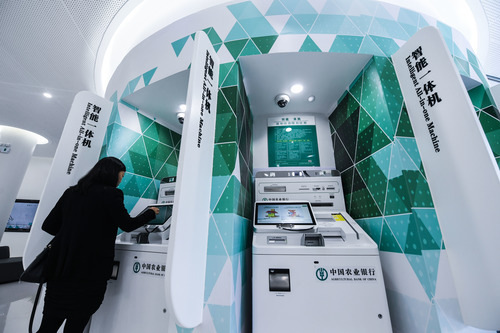
BEIJING, Oct. 22 (Xinhua) -- When was the last time you visited a bank? Many elderly people find that branches near their homes have been closed, thus having to go long distances to another one.
A list of exiting commercial banking institutions by China Banking and Insurance Regulatory Commission show that 6,366 branches of commercial banks have been shut down in the past two years, and as of October 16 this year, there are more than 2,000 branch closures, according to a report by International Financial News.
Traditional banks have embarked on the path of smart transformation. The used-to-be-everywhere physical branches are slimming away, along with roadside ATMs. But such offline to online banking transformation encounter difficulties as well during the process.
Physical facilities disappearing
The pinch on physical branches is felt looking through banks' annual reports. Statistics show that in the first half this year, China's six largest banks have closed 1,343 branches, of which the Agricultural Bank of China contributed 1,149.
Gone are also ATMs as mobile banking and electronic payments have become mainstream. Latest data from the People's Bank of China show that there were 1,052,100 ATMs in China as of the end of the second quarter of 2020, indicating 30,900 ATMs gone compared with first-quarter-end figure. The number of ATMs per 10,000 people in China was 7.52, a decrease of 2.85 percent quarter on quarter.
Those numbers tell the story of trending digital economy nationwide. Online banking has been developing fast and played a major role in terms of cushioning negative impacts from the Covid-19 pandemic, said Shen Jianguang, Chief Economist at JD Digits, adding that circumstances like the pandemic also leads to fewer people go to physical branches thus further cuts on branches and staff.
The booming digital industry could be a major supporting factor in the recovery of China's economy, particularly after the pandemic, Shen said.
The number of online transactions of financial banking institutions reached 163.784 billion in 2019, a year-on-year increase of 7.42 percent, according to a report by China Banking Association. Among them, the number of mobile banking transactions reached 121.451 billion, up 38.88 percent year-on-year.
Changes are also taking place in remaining physical branches, as the crowds of people that used to queue for banks are no longer visible even for weekends.
With the guidance of bank staff, customers are able to handle 90 percent of personal non-cash business such as opening an account, printing statements, password resetting, personal information changes, all using an automated banking machine for a dozen of minutes.
In 2019 alone, there were 15,591 physical branches renovated nationwide. As of September this year, all 22,000 branches of the Agricultural Bank of China have completed smart upgrading.
But physical branches are still irreplaceable especially in strengthening customers ties, said Su Xiaorui, a researcher at Madai Licai. Banks should continuously improve customer experience and customer relations while upgrading offline physical facilities, Su suggested.
Intelligent transformation trending
Banks have been striving to break through physical barriers in recent years. Thanks to 5G development, customers are able to experience technology such as biometric identification, big data analysis, holographic projection in some intelligent branches.
Future smart transformation for bank branches is likely to happen on three levels, namely the application of equipment and facilities, the going online of business and transactions, as well as the cultivation of digital talents, according to Deng Yu, a senior researcher at Xize Institute.
The banking industry is currently in a trend of digital transformation. The implementation of smart branches is not only a move by commercial banks to actively embrace technology and seek change, but is also the trend of the industry. At present, there is no standardized model for smart transformation, which requires banks to adjust measures to local conditions step-by-step, said Su Xiaorui.
However, after smart transformation, banks also need to keep pace with times in areas of marketing channels and responding to customer need changes.
Su Xiaorui believes that following the transformation, banks should utilize intelligent means to strengthen brand promotion, optimize product design, strengthen interactive communication, guide users to intelligent branches to operate, gradually cultivate user habits, and improve user stickiness. These measures will lay a solid foundation for the bank's eventual overall digital and smart transformation.
Accordingly, banks should reasonably plan branches and ATMs, encourage branches and ATMs to provide services that are difficult to manage online, and accelerate the integration of online and offline channels to provide customers with services any time, any place and any way, said Dong Ximiao, chief researcher at Merchants Union Consumer Finance.
Pan Helin, executive dean of the Digital Economics Research Institute at Zhongnan University of Economics and Law, highlighted the difficulties faced by banks during transformation from offline to online.
The decline in banking business this year is quite serious and it is not a periodical problem, Pan said, noting that because of the large number of homogenized banks in China and pressure from online finance, competitive pressure will only become more and more serious in the future.
In terms of advancing business expansion, what traditional banks lack is a way to attract traffic, and also, not all banks can successfully break through in such changing times, Pan said. (Edited by Niu Huizhe with Xinhua Silk Road, niuhuizhe@xinhua.org)




 A single purchase
A single purchase









